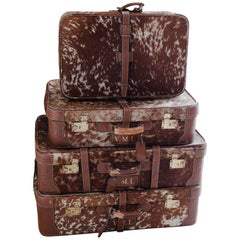Bie Baert Trunks and Luggage
to
2
2
2
1
1
2
2
2
2
2
2
2
Early 20th Century Vellum Suitcase
Located in Brecht, BE
charming suitcase, from the 1920's
Category
Early 20th Century French Trunks and Luggage
Materials
Leather
20th Century French Set of Four Suitcases, Leather and Ponyskin
Located in Brecht, BE
Elegant, quirky, eccentric set of four suitcases, made in France, leather
and ponyskin, initials V.M.L.
Dimensions :
1 x 60 x 40 cm x 17 cm high
1 x 70 x 45 cm x 19 cm high
2 x ...
Category
Mid-20th Century French Trunks and Luggage
Materials
Leather
Related Items
20th Century Louis Vuitton Suitcase In Natural Cow Hide, France c.1910
By Louis Vuitton
Located in Royal Tunbridge Wells, Kent
A highly unusual and exceptionally rare Louis Vuitton suitcase, originating from the early years of the 20th century, distinguishes itself not with the globally renowned monogram canvas but with a distinctive covering crafted from a singular piece of cowhide. This unique piece represents a special order from Louis Vuitton, showcasing the brand's historical commitment to utilising only the finest hides available.
Unlike many of its counterparts, leather trunks and cases of this era often struggle to withstand the test of time, requiring regular treatments to prevent drying and disintegration. Remarkably, this particular example defies the odds, retaining the same supple quality it possessed on the day it first graced the shop floor. This suitcase belongs to Louis Vuitton's collection of "speciality materials," which encompasses a diverse range, including, but not limited to, zinc, copper, crocodile leather, and cow leather.
A brief history about Louis Vuitton trunks: Louis Vuitton was born in 1821 to a farmer and milliner and came from a long-established working-class family in eastern France. Vuitton grew up understanding the effects of perseverance and a strong work ethic from watching his family. At the age of 16, he made the decision to walk 292 miles from his hometown to Paris to try and make a new life for himself. When he arrived the city was in the midst of industrialization with current modes of transportation evolving quickly allowing for longer journeys. With this came the need for sturdy travel pieces.
Vuitton was taken as an apprentice for a successful box maker and packer named Monsieur Marechal. He learned to craft durable containers and how to pack them properly – a well-respected profession at the time.In 1854, years after he had mastered his craft and became well respected for it, Vuitton ventured out on his own to open a shop on Rue Neuve des Capucines. It was here that he began to establish himself as a luggage maker. Then, in 1858, Vuitton designed the first Louis Vuitton steamer trunk. At the time trunks had rounded tops to allow for water to run off but this did not allow for convenient stowage. Vuitton introduced a flat, yet waterproof, trunk that was easily stackable. The first of his trunks were outfitted with a grey canvas referred to as Trianon – it wouldn’t be until several decades later that the signature monogram would be introduced.
With a burgeoning business, Vuitton moved his family and workplace to Asniere, where he employed twenty workers to craft his trunks. By 1900 he would have 100 employees, and in 1914 the company would more than double in size. After years of success, Vuitton began to experiment with the design of his luggage by introducing a new striped canvas pattern (1876) and later the still well-known Damier print (1888). The hand-painted patterns were developed to prevent counterfeits. Even in the late 1800s, Louis Vuitton was enough of a status symbol to warrant counterfeiting. In 1886, his son George invented and patented an ingenious locking system that made it impossible to pick the lock of their trunks. This lock is still used today.
1892 would prove to be a time of mourning for the family as Louis Vuitton passed...
Category
20th Century French Other Trunks and Luggage
Materials
Brass
$4,321
H 6.7 in W 25.99 in D 16.93 in
Early 20th Century Musical Bird Automaton
Located in Middleburg, VA
An automated singing bird with a strong voice and flamboyant plumage amidst foliage in a gilded brass cage. Germany, circa 1920.
This beautiful, vintage songbird collectible will ad...
Category
Early 20th Century Bird Cages
Materials
Metal, Brass
20th Century Louis Vuitton Suitcase Alzer 80, 1970
By Louis Vuitton
Located in Epfach, DE
909481 Alzer 80 80 cm x 26 cm 52.5 cm with removable tray
Louis Vuitton suitcase, Alzer 80 with removable tray, in wonderful, well-kept condition with origin...
Category
20th Century French Trunks and Luggage
Materials
Leather
Antique LOUIS VUITTON Leather Hardcase Suitcase – Early 20th Century
By Louis Vuitton
Located in Victoria, BC
A distinguished piece of travel history, this antique Louis Vuitton hardcase suitcase is a fine example of the craftsmanship that defined luxury travel in the early 20th century. Con...
Category
Early 20th Century French Trunks and Luggage
Materials
Leather
19th Century English Leather Suitcase
Located in Chicago, IL
This 19th-century English leather suitcase is a charming relic of refined travel in a bygone era. Crafted from supple leather, its surface shows wear and patina that highlight its ag...
Category
Antique 19th Century English Edwardian Trunks and Luggage
Materials
Leather
20th Century Louis Vuitton Suitcase In Monogram Canvas, France c.1970
By Louis Vuitton
Located in Royal Tunbridge Wells, Kent
A charming Louis Vuitton hard-sided case, mid to late 20th century, the exterior finished in the famous monogram canvas with brass fittings. A great piece for use today or as a decor...
Category
20th Century French Other Trunks and Luggage
Materials
Brass
$4,185
H 18.51 in W 27.56 in D 8.67 in
Early 20th Century French Oak Library Ladder
Located in Chicago, IL
A monumental and sculptural early 20th century French oak library ladder with eight steps, handrails, and a shelf at the top for setting books on. The perfect decorative and functional ladder for your home library...
Category
Antique Early 1900s French Ladders
Materials
Oak
French Parchment / Vellum Suitcases as Side Table
By Innovation
Located in Barcelona, ES
A set of high quality French luxury vellum suitcases. France, 1920-1930s.
Made in wood and parchment with brass studs and lock plates in brass and leat...
Category
20th Century French Trunks and Luggage
Materials
Brass
20th Century Louis Vuitton Suitcase Classic Monogram Canvas 60s
By Louis Vuitton
Located in Turin, Turin
Timeless suitcase by Louis Vuitton from the 60s with rounded edges and a double zipper. It is easy to carry with its comfortable rounded handles and bears a removable ID holder. It i...
Category
Vintage 1960s French Modern Trunks and Luggage
Materials
Leather
$4,660
H 13.78 in W 21.26 in D 7.49 in
20th Century Revelation Expanding Leather Suitcase, c.1920
Located in Royal Tunbridge Wells, Kent
Antique early 20th Century Bridle Hide Revelation expanding leather suitcase, a hallmark of innovation from the 1920's, showcased a pioneering design that allowed for adjustable stor...
Category
20th Century British Trunks and Luggage
Materials
Brass
Early 20th C. Classical Style Globe
Located in Los Angeles, CA
Vintage globe mounted on a mahogany wooden stand with three elegantly turned legs. A brass colored meridian ring encircles the globe, adding to its antique aesthetic. The wooden st...
Category
Vintage 1940s American American Classical Globes
Materials
Mahogany
20th Century Four Panel Hand Painted Screen
Located in Miami, FL
An Italian hand painted wood room divider from the 20th century. This antique accordion style folding screen from Italy features 4 connected panels, ...
Category
Mid-20th Century Italian Art Nouveau Screens and Room Dividers
Materials
Wood



